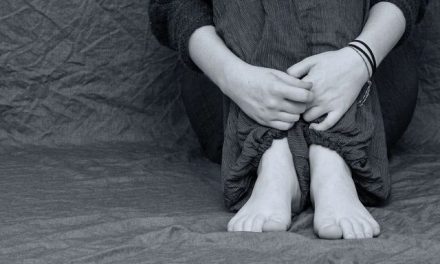
Buddhism has long encouraged personal responsibility and action (the word “karma” actually means action). Hard work and perseverance are good things, and valuable. However, they are rarely the sum total of why someone is, or isn’t, suffering. Our job as connected beings isn’t to judge and punish but to care and learn. To do that, we are going to have to let go of those bootstraps
By Kellie Schorr
“Before you ask me any kind of medical question you should probably know that my family is from Appalachia,” I warn people poised to talk to me about their ailment. “I cure everything with vinegar.”
Or mint leaves. Or cranberry juice. Let’s just say you’re better off asking the teen clerk at Walgreens than coming to me. But if you’re gonna show me some nasty scaly thing on your skin, oh my gosh, get some apple cider vinegar on that, stat!
My father, raised on a Tennessee farm, left the hills to “fight in the war” (WWII). His physical for the Army Air Corps was the first time he’d ever seen a doctor in his life. The military educated him and, when the war was over, found him a job with Martin Marietta Aerospace, where he worked for over 40 years. As a result, he was able to go to doctors when something wasn’t right. Still, he’d give the vinegar a try first. You can leave Appalachia, but it never leaves you.
When I tell that story, it’s amazing how people respond to it.
Others: “Mountain people were so wise and strong. They didn’t complain. They used the land to heal themselves and went back to work.”
Me (probably because I share their DNA and cornbread): “My extended family worked very hard and were so financially poor that they ended up practicing their own medicine. It worked, sometimes. They suffered, other times.”
Others: “That’s what everyone needs to do! Go into the Army if you want an education.”
Me (probably because my father couldn’t talk about the war without a haunted cloud in his otherwise bright blue eyes, and I watched him suffer in silence for the rest of his life about what he had experienced): “Going to war is a ridiculously high price to pay for an education.”
Others: “Your dad did it the right way. He pulled himself up by the bootstraps!”
Me: “It’s 2020. Why the hell are we still talking about bootstraps?”
We Don’t Understand Bootstraps
When people who suggest individuals should engage in hard work and perseverance, instead of getting help from a program or policy, talk about “pulling yourself up by the bootstraps” they are misinterpreting both the actual bootstrap, and what the phrase was supposed to mean.
Bootstraps, those handy little leather loops sewn into the top of long boots and heavy shoes, didn’t come into prominence until the 1800’s. Prior to that, boots were sold in pieces with wrap-around leather extensions. When Hessian boots, made in one long piece, became a fashion trend in both England and America, the bootstrap was developed because they were notoriously hard to put on. Bootstraps weren’t designed to keep people from needing or accepting help, but to actually be the help people needed.
You can’t lift yourself up with them, but you can get in your boots because someone cared enough to sew a strap on them for you.
The phrase itself, “pull yourself up by the bootstraps” dates all the way back to 1834, where it was used to describe something both impossible and ridiculous. [1] It was a popular idiom to denote someone setting out on a fool’s errand (“If Mr. Parker thinks he is going to beat Teddy Roosevelt, he might as well try to pull himself up by his own bootstraps”).
Somewhere in the 1940’s, during that time my father was enduring the atrocities of war so he could learn math and science, the phrase evolved to highlight the workman’s boots, and encourage the laborer to put in long hours for little pay to aid the common good and not ask for help.
In our current culture where many working people wear athletic shoes, steel-tipped ankle cut work boots, heels, or Oxfords, talking about someone’s bootstraps is dated and misinformed, lacking in both clarity, and compassion. There’s the trouble.
The Reality of Bootstrap Ideology
Beyond historical inaccuracy, the myth of the “self-made person” has the insidious side-effect of bypassing the need for change with words that create stereotypes (“People who need help are lazy. They just want a handout.”) and serve only to justify inaction. Bootstrap ideology is the opposite of Buddhism which has interdependence as one of its foundational ideas.
When we engage in discussion on issues such as health care access, poverty, social justice and workplace reform with the blanket statement that people just need to “pull themselves up” we are actively resisting an inherent truth. We are all connected. We pull each other up. If we are left to flounder without help or justice, we will eventually drag each other down.
Please note, this is not a partisan thought. It doesn’t matter who your candidate is, whether you’re red or blue or stand askew, what ideas you hold about how much of a role government should play in individual care, or which side of the room you sit on in any debate.
What does matter is that you approach every single situation with a mind for reality and a center of compassion.
The reality is: You can’t pull yourself up by your own bootstraps (they are actually tethers).
The compassion is: We need to care about why people are having trouble standing and the suffering it causes.
Buddhism has long encouraged personal responsibility and action (the word “karma” actually means action). Hard work and perseverance are good things, and valuable. However, they are rarely the sum total of why someone is, or isn’t, suffering. Our job as connected beings isn’t to judge and punish but to care and learn. To do that, we are going to have to let go of those bootstraps.
Bootstrap ideology is the opposite of Buddhism which has interdependence as one of its foundational ideas. ~ Kellie Schorr Click To Tweet
Beyond Bootstraps
Most of us in America have been raised with bootstrap ideology and like all “concepts” it makes it harder for us to awaken and see clearly. It keeps us from asking all the questions. Here’s an example:
A popular set of stories that regularly circulate on social media shows teens and children who use hard work and sacrifice to help a family member or friend. You’ve seen them:
- “Beating the Odds: More than 100 homeless kids graduated from high school this year.” (CNN)
- “Nine-year-old sells lemonade to help pay for baby brother’s medical bills.” (New York Post)
- “Boy saves up allowance and birthday gifts then pays friend’s lunch debt.” (The Hill).
On the surface these stories sound amazing, aspirational, and even necessary in a world desperate for good news. They fit perfectly within our bootstrap acculturation to work hard with what you have. While they can inspire us, (and the subjects of these stories deserve recognition and merit for their acts of work and generosity) they also keep us from asking important things.
- Why are there so many homeless children? What happened to the ones who didn’t graduate?
- Why are so many hard working people in this country using Go Fund Me and lemonade stands to pay for healthcare?
- Why are school children in debt for food?
The answers to those questions are diverse and each has their own positives and pitfalls. What is important is that you see past the “feel good messaging” of the story and ask the questions that can bring you more understanding.
To have a Buddhist practice doesn’t mean knowing the answers to all the questions, questioning all the answers, or getting rid of the questions altogether (that’s called spiritual bypassing). Buddhism is about awakening to our impermanent, conditional, interdependent reality and asking the most important question of all:
What can I do to stop, or at least ease, suffering? I can’t tell you what the answer to that question in each situation is, but I can tell you it’s not “pull yourself up by your bootstraps.”
Also, it wouldn’t hurt to keep some vinegar around. Just sayin’.
____
[1] Zimmer, Benjamin, “Figurative Bootstraps” Ad-1 List, Linguists.Org, 2005.
Photo: Pixabay
Editor: Dana Gornall
Were you inspired by this post? You might also like:
Comments
- Man or Bear? What would the Buddha Choose? - May 7, 2024
- Jesus Washed Feet: What A Superbowl Ad Can Really Teach Us - February 16, 2024
- Secret Agent Swift? The Suffering Of Conspiracy Theorists - February 1, 2024




